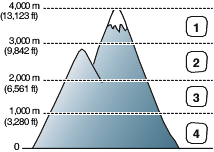After installation is complete, you may want to set the machine’s default settings. Refer to the next section if you would like to set or change values. This chapter gives you step-by-step instructions for setting up the machine.
The print quality is affected by atmospheric pressure, which is determined by the height of the machine above sea level. The following information will guide you on how to set your machine to the best print quality or best quality of print.Before you set the altitude value, determine the altitude where you are.

|
|
You can altitude adjustment in Printer Settings Utility.
-
Double-click the icon on the Windows task bar (or Notification Area in Linux). You can also click on the status bar in Mac OS X (See Using the Smart Panel program).
Or, if you are a Windows user, you can launch it from the menu, select or > > your printer driver name > Smart Panel.
-
Click .
-
Select necessary options in the drop-down list.
-
Click the button.
If your machine is connected to a network, SyncThru™ Web Service screen appears automatically. This can also be adjusted via SyncThru™ Web Service.
You can select the tray and paper you would like to keep using for printing job.
-
Click the Windows menu.
-
For Windows 2000, select > .
-
For Windows XP/Server 2003, select .
-
For Windows Server 2008/Vista, select > > .
-
For Windows 7, select > .
-
For Windows Server 2008 R2, select > > .
-
-
Right-click on your machine.
-
For Windows Server 2003/Server 2008/XP/Vista, press .
For Windows 7/Server 2008 R2, from context menus, select the .
![[Note]](../common/note.png)
If item has a ► mark, you can select other printer drivers connected with the selected printer.
-
Click tab.
-
Select options such as number of copies, paper size or paper type.
-
Press .
![[Note]](../common/note.png)
|
|
|
If you want to use special-sized paper such as a billing paper, select in the tab in the (See Opening printing preferences). |
Macintosh does not support this function. Macintosh users need to change the default setting manually each time they want to print using other settings.
-
Open a Macintosh application and select the file you want to print.
-
Open the menu and click .
-
Go to pane.
-
Set appropriate tray from which you want to print.
-
Go to pane.
-
Set paper type to correspond to the paper loaded in the tray from which you want to print.
-
Click to print.
When you will not be using the machine for a while, you can use this feature to save power.
You change power save in Printer Settings Utility.
-
Double-click the icon on the Windows task bar (or Notification Area in Linux). You can also click on the status bar in Mac OS X (See Using the Smart Panel program).
Or, if you are a Windows user, you can launch it from the menu, select or > > your printer driver name > Smart Panel.
-
Click .
-
Click > . Select the appropriate value from the drop-down list, and then click .
Your machine has preset font setting depending on your region or country.
If you want to change the font or set the font for special condition, such as the DOS environment, you can change the font setting as follows:
-
Double-click the icon on the Windows task bar (or Notification Area in Linux). You can also click on the status bar in Mac OS X (See Using the Smart Panel program).
Or, if you are a Windows user, you can launch it from the menu, select or > > your printer driver name > Smart Panel.
-
Click .
-
Click .
-
Confirm if is selected in .
-
Click .
-
Select your preferred font in the set list.
-
Click .
![[Note]](../common/note.png)
|
|
|
Following information shows the proper font list for corresponding languages.
|
Print quality is affected by humidity levels. Paper may be damp if your location is a humid area: set the humidity mode.
-
Ensure that you have installed the printer driver with the provided Printer Software CD.
-
Double-click the icon on the Windows task bar (or Notification Area in Linux). You can also click on the status bar in Mac OS X.
-
Click .
![[Note]](../common/note.png)
If your machine is connected to the network, you can set the humidity mode via SyncThru™ Web Service.
-
Click > . Select the appropriate value from the drop-down list, and then click .